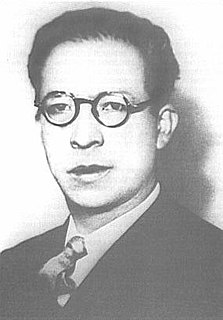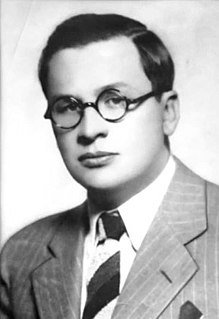Related Research Articles

The Revolutionary Nationalist Movement is a political party in Bolivia and was the leading force behind the Bolivian National Revolution from 1952 to 1964. It influenced much of the country's history since 1941.

Hernando Siles Reyes was a Bolivian politician who served as the 31st President of Bolivia from 1926 to 1930. The founder of the Nationalist Party, he soon gravitated toward the Saavedrista faction of the Republican Party, which had come to power in 1920. Chosen by President Saavedra to be his successor in 1926, Siles ran on a ticket that included the latter's brother, Abdon Saavedra, as his vice-presidential running mate. This formula won the elections, and Siles Reyes was sworn in August, 1926. Soon, he came to be regarded as one of the most charismatic Bolivian politicians in recent memory, especially when he broke openly with the domineering ex-President Bautista Saavedra, and exiled him along with his brother. Despite all this, the Siles government soon ran into economic and political difficulties associated with the far-reaching effects of the "crash" of 1929. Moreover, his term was marked by rising diplomatic tensions with neighboring Paraguay which would later lead to the Chaco War. Many more opponents were exiled, giving Siles some breathing room, but matters reached a breaking point when, in 1930, the President attempted to unilaterally increase his term in office, ostensibly to deal with the mounting economic and international crisis. This was all his opponents needed, and with a coup d'état clearly in the offing, Siles resigned on May 28, 1930, leaving his cabinet in charge. The latter was overthrown by General Carlos Blanco, who in 1931 called elections which were won by Daniel Salamanca of the Partido Republicano-Genuino. Siles lived the rest of his life in exile, dying in Lima in 1942 at the age of 60.

Carlos Quintanilla Quiroga was a Bolivian general who served as the 37th president of Bolivia on a provisional basis from 1939 to 1940. Quintanilla saw action in the initial stages of the Chaco War (1932–1935) and managed to ascend the echelon of the Bolivian armed forces until he became commander of the army during the administration of Germán Busch. When President Busch committed suicide on 23 August 1939, Quintanilla declared himself Provisional President of the Republic.
Bolivia's defeat by Paraguay in the Chaco War of 1932–1936 marked a turning point in the modern history of Bolivia. Great loss of life and territory discredited the traditional ruling classes, while service in the army produced stirrings of political awareness among the indigenous people. A large portion of the contested Gran Chaco region was surrendered to Paraguay. In return Bolivia was given access to the Paraguay River where Puerto Busch was founded and, with this, free access to the Atlantic Ocean through international waters was possible. In 1936 Standard Oil's Bolivian operations were nationalized and the state-owned firm Yacimientos Petroliferos Fiscales Bolivianos (YPFB) was created. From the end of the Chaco War until the 1952 Bolivian National Revolution, the emergence of contending ideologies and the demands of new groups convulsed Bolivian politics.
The Socialist Republican Party, whose members were also known as "Saavedristas", was a political party in Bolivia. The Socialist Republican Party emerged on January 28, 1921, as the Republican Party was bifurcated on the same day Bautista Saavedra took office as President of the country. The Socialist Republican Party was formed by Saavedra's followers.

General elections were held in Bolivia on 29 June 1980, the third in three years. As no candidate in the presidential elections received a majority of the vote, the National Congress was required to elect a President on 6 August. With Hernán Siles Zuazo of the Democratic and Popular Union the favourite to win the Congressional ballot, the process was disrupted on 17 July by the military coup led by General Luis García Meza Tejada. However, Meza was pressured to resign on 4 August 1981, resulting in General Celso Torrelio becoming president. In July 1982 he was replaced by General Guido Vildoso, who was named by the high command to return the country to democratic rule. On 17 September 1982, during a general strike that brought the country close to civil war, the military decided to step down, to reconvene the National Congress elected in 1980, and to accept its choice of president. Accordingly, the National Congress revalidated the 1980 election results on 23 September and overwhelmingly elected Hernán Siles Zuazo as president on 5 October. He subsequently assumed the presidency on 10 October 1982.
The Genuine Republican Party was founded in Bolivia in 1921 by José María Escalier and Daniel Domingo Salamanca Urey following a split in the Republican Party.
The first Bolivian Socialist Parties were established in 1913–1935.
The United Socialist Party was founded on 15 March 1936, as the result of a split in the Nationalist Party in 1936 and the adhesion of some prominent members of the Republican Socialist Party in 1937, and backed by Legion of Veterans and by the regional socialist groups.
The Independent Socialist Party was founded in March 1938 by Víctor Paz Estenssoro, Carlos Salamanca, Jorge Aráoz Campero, Carlos Montenegro and Augusto Céspedes, following a split in the United Socialist Party.
The Authentic Revolutionary Party was a political party in Bolivia.
The Leftwing Revolutionary Nationalist Movement was a centre-left political party in Bolivia.
The Socialist Party was a left-wing (socialist) political party in Bolivia.
1920 Bolivian coup d'état was a bloodless takeover of power in Bolivia by the Republican party on July 12, 1920 which overthrew the previously ruling government of the Liberal Party and brought Bautista Saavedra to power as President from 1920 until 1925.

Gualberto Villarroel assumed office as the 39th President of Bolivia on 20 December 1943, and his term was violently cut short by his death on 21 July 1946. A colonel during the Chaco War, Villarroel and the Reason for the Fatherland (RADEPA) military lodge joined the fledgling Revolutionary Nationalist Movement (MNR) to overthrow President Enrique Peñaranda in a coup d'état.

The 1936 Bolivian coup d'état, also known as the Socialist Revolution of 1936, was a civil-military coup in Bolivia that deposed President José Luis Tejada Sorzano, bringing an end to traditional political order and bringing forward the period of Military Socialism in the country. On 17 May 1936, following the largest strike movement known until then in Bolivia, the military under the young lieutenant colonel Germán Busch overthrew the government of Tejada. Busch held the reigns of government until 22 May when Colonel David Toro arrived from the Chaco and assumed the presidency under a military junta supported by the army, organized labor, and the United Socialist Party.

Gabriel Gosálvez Tejada was a Bolivian politician, journalist, economist, and diplomat. Throughout his political career, Gosálvez held various ministerial officers and diplomatic posts as a member of the United Socialist Party. When that party merged into the Republican Socialist Unity Party, Gosálvez was presented as its presidential candidate in the 1951 general election.
The Government Junta of Bolivia was a civil-military junta which ruled Bolivia from 20 December 1943 through 5 April 1944. It consisted of representatives of the armed forces through the Reason for Fatherland (RADEPA) military lodge as well as members of the Revolutionary Nationalist Movement (MNR). The President of the Junta was Colonel Gualberto Villarroel who came to power after a coup d'état which overthrew the government of Enrique Peñaranda. Immediately upon its inception, the junta faced a diplomatic blockade by the United States who viewed the MNR as sympathetic to the fascist powers of World War II and as such led the rest of Latin America in refusing to recognize the new regime until all members of the MNR were removed from the administration. After months of attempted negotiations and the removal of several cabinet ministers, the government finally relented and dismissed all remaining MNR members, dissolving the junta and entrusting Villarroel with the provisional Presidency of the Republic on 5 April 1944.

Carlos Montenegro Quiroga was a Bolivian lawyer, writer, journalist, and politician. He was the principal political theorist of the Revolutionary Nationalist Movement, co-founding the party newspaper La Calle which laid the ideological bases of movement. His most famous work Nacionalismo y coloniaje (1943), an essay on the influence of journalism in the history of Bolivia, is considered to be one of the most influential works in Bolivian historiography.
References
- ↑ Political parties of the Americas: Canada, Latin America, and the West Indies, Vol.1. Greenwood Press, 1982. P.136.
- ↑ James M. Malloy. Bolivia: the uncompleted revolution. University of Pittsburgh Pre, 1970. P.353.
- ↑ James M. Malloy. Bolivia: the uncompleted revolution. University of Pittsburgh Pre, 1970. Pp.65-66.
- ↑ Political handbook of the world 1941. New York, 1941. P. 14.
- ↑ Political parties of the Americas: Canada, Latin America, and the West Indies, Vol.1. Greenwood Press, 1982. P.136.